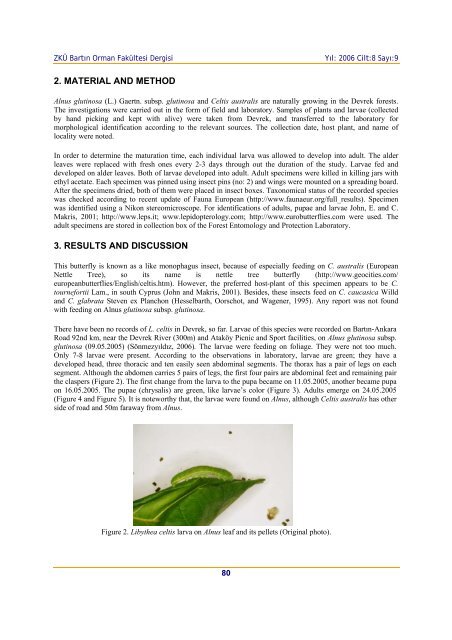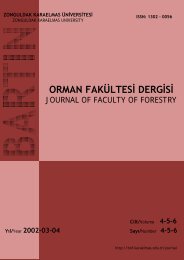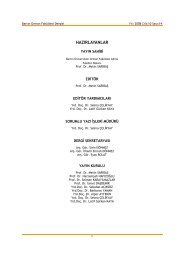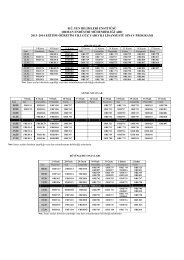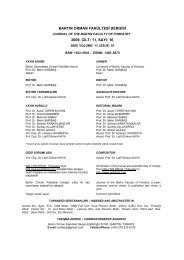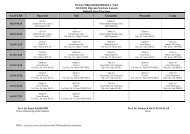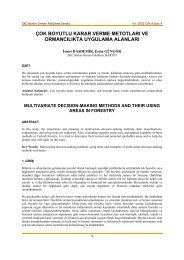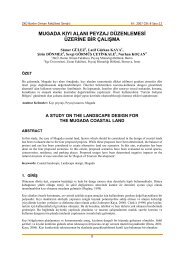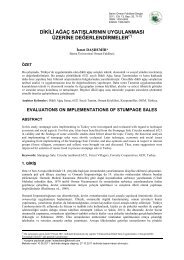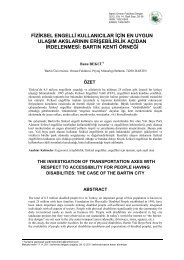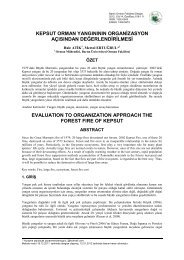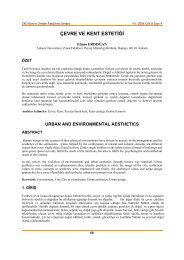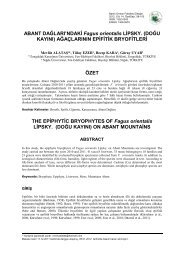Create successful ePaper yourself
Turn your PDF publications into a flip-book with our unique Google optimized e-Paper software.
ZKÜ Bartın Orman Fakültesi Dergisi<br />
Yıl: 2006 Cilt:8 Sayı:9<br />
2. MATERIAL AND METHOD<br />
Alnus glutinosa (L.) Gaertn. subsp. glutinosa and Celtis australis are naturally growing in the Devrek forests.<br />
The investigations were carried out in the form of field and laboratory. Samples of plants and larvae (collected<br />
by hand picking and kept with alive) were taken from Devrek, and transferred to the laboratory for<br />
morphological identification according to the relevant sources. The collection date, host plant, and name of<br />
locality were noted.<br />
In order to determine the maturation time, each individual larva was allowed to develop into adult. The alder<br />
leaves were replaced with fresh ones every 2-3 days through out the duration of the study. Larvae fed and<br />
developed on alder leaves. Both of larvae developed into adult. Adult specimens were killed in killing jars with<br />
ethyl acetate. Each specimen was pinned using insect pins (no: 2) and wings were mounted on a spreading board.<br />
After the specimens dried, both of them were placed in insect boxes. Taxonomical status of the recorded species<br />
was checked according to recent update of Fauna European (http://www.faunaeur.org/full_results). Specimen<br />
was identified using a Nikon stereomicroscope. For identifications of adults, pupae and larvae John, E. and C.<br />
Makris, 2001; http://www.leps.it; www.lepidopterology.com; http://www.eurobutterflies.com were used. The<br />
adult specimens are stored in collection box of the Forest Entomology and Protection Laboratory.<br />
3. RESULTS AND DISCUSSION<br />
This butterfly is known as a like monophagus insect, because of especially feeding on C. australis (European<br />
Nettle Tree), so its name is nettle tree butterfly (http://www.geocities.com/<br />
europeanbutterflies/English/celtis.htm). However, the preferred host-plant of this specimen appears to be C.<br />
tournefortii Lam., in south Cyprus (John and Makris, 2001). Besides, these insects feed on C. caucasica Willd<br />
and C. glabrata Steven ex Planchon (Hesselbarth, Oorschot, and Wagener, 1995). Any report was not found<br />
with feeding on Alnus glutinosa subsp. glutinosa.<br />
There have been no records of L. celtis in Devrek, so far. Larvae of this species were recorded on Bartın-Ankara<br />
Road 92nd km, near the Devrek River (300m) and Ataköy Picnic and Sport facilities, on Alnus glutinosa subsp.<br />
glutinosa (09.05.2005) (Sönmezyıldız, 2006). The larvae were feeding on foliage. They were not too much.<br />
Only 7-8 larvae were present. According to the observations in laboratory, larvae are green; they have a<br />
developed head, three thoracic and ten easily seen abdominal segments. The thorax has a pair of legs on each<br />
segment. Although the abdomen carries 5 pairs of legs, the first four pairs are abdominal feet and remaining pair<br />
the claspers (Figure 2). The first change from the larva to the pupa became on 11.05.2005, another became pupa<br />
on 16.05.2005. The pupae (chrysalis) are green, like larvae’s color (Figure 3). Adults emerge on 24.05.2005<br />
(Figure 4 and Figure 5). It is noteworthy that, the larvae were found on Alnus, although Celtis australis has other<br />
side of road and 50m faraway from Alnus.<br />
Figure 2. Libythea celtis larva on Alnus leaf and its pellets (Original photo).<br />
80


